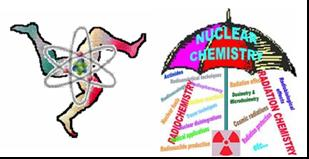Speaker
Dr
Shun Sekimoto
(Kyoto University Research Reactor Institute (KURRI))
Description
High-energy proton beams traveling in air and beam sprays from the interaction of the beam with the target and related target station components produce radioactive aerosols in the target area. We report on the measurements of the radioactive aerosols produced in the Fermilab Anti-proton target station (AP0), where 120-GeV proton beam interacts with an Inconel target. Radioactive aerosols are produced either by direct activation by the beam and its secondaries and/or the subsequent attachment of the various radio-nuclides produced by other nuclear spallation reactions in the target, in the instruments around the target, air and other sources. The radio-nuclide composition of the radioactive aerosols and their correlation to the aerosol size distribution has not been studied previously. In order to control external and internal exposure of the workers to radioactive aerosols, it is important to understand the dynamics of radioactive aerosols in an accelerator target area.
In this work, we separated radioactive aerosols which were collected from the AP0 target vault into several samples according to particulate size ranging from 0.056 to 10 micro-meters by using the “impactor method.” The particulate size distributions of radioactive aerosols associated with corresponding radio-nuclides were obtained by measuring the gamma rays of various radio-nuclides in each sample. The following fourteen radio-nuclides were identified in the aerosol samples: Na-24, Au-198, Sc-47, Au-196, V-48, Cr-51, Be-7, Co-56, Co-58, Sc-46, Co-57, Mn-54, Na-22 and Co-60 in the order of their half-lives. Consequently, it was found that the particle size distribution of radioactive aerosols is correlated with the half-lives of their constituent radio-nuclides. Based on the results, the dynamical and the formation mechanism of radioactive aerosols in the target area will be studied further.
Author
Dr
Shun Sekimoto
(Kyoto University Research Reactor Institute (KURRI))
Co-authors
Akihiro Toyoda
(KEK)
Anthony Leveling
(FNAL)
David Boehnlein
(Fermi National Accelerator Laboratory (FNAL))
Gary Lautenschlager
(FNAL)
Hiroshi Matsumura
(High Energy Accelerator Research Organization (KEK))
Hiroshi Nakashima
(JAEA)
Hiroshi Yashima
(KURRI)
Kamran Vaziri
(FNAL)
Koji Oishi
(Shimizu Corporation)
Naoyuki Osada
(KURRI)
Nikolai Mokhov
(FNAL)
Norihiro Matsuda
(Japan Atomic Energy Agency (JAEA))
Seiichi Shibata
(KURRI)
Yoshimi Kasugai
(JAEA)
Yuichi Oki
(KURRI)
Yukio Sakamoto
(JAEA)
